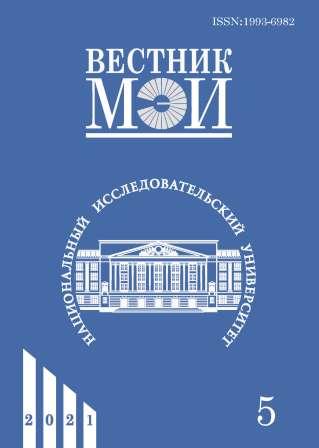Heat Removal and Thermal Stabilization of High-temperature Surfaces by a Dispersed Coolant Flow
Abstract
The effectiveness of stabilizing the surface temperature by a dispersed coolant flow is experimentally studied on a bench simulating energy intensive elements of thermonuclear installations A test section in which the maximum heat flux density can be obtained when being subjected to high-frequency heating was developed, manufactured, and assembled. The test section was heated using a VCh-60AV HF generator with a frequency of not lower than 30 kHz. A hydraulic nozzle with a conical insert was used as the dispersing device. Techniques for carrying out an experiment on studying a stationary heat transfer regime and for calculating thermophysical quantities were developed. The experimental data were obtained in the stationary heat transfer regime with the following range of coolant operating parameters: water pressure equal to 0.38 MPa, water mass flow rate equal to 5.35 ml/s, and induction heating power equal to 6--19 kW. Based on the data obtained, the removed heat flux density and the heat transfer coefficients were calculated for each stationary heat transfer regime. The dependences of the heat transfer coefficient on the removed heat flux density and of the removed heat flux density on the temperature difference have been obtained. High values of heat transfer coefficients and heat flux density at a relatively low coolant flow rate were achieved in the experiments.
References
2. Kim J. Spray Cooling Heat Transfer: the State of the Art // Intern. J. Heat Fluid Flow 2007. V. 28. Pp. 753—767.
3. Wen-Long Cheng, Wei-Wei Zhang, Hua Chen, Lei Hu. Spray Cooling and Flash Evaporation Cooling: the Current Development and Application // Renewable and Sustainable Energy Rev. 2016. V. 55. Pp. 614—628.
4. Youssef M.R. Modeling the Effect of a Spray on a Liquid Film on a Heated Surface. Morgantown: West Virginia University, 2007.
5. Zhao, R., Cheng, W., Liu, Q., Fan, H. Study on Heat Transfer Performance of Spray Cooling, Model and Analysis // Heat Mass Transfer. 2010. V. 46. Pp. 821—829.
6. Kazachkov I.V. Heat Transfer and Dynamics of the Droplet on a Superheated Surface // Heat Mass Transfer. 2012. Iss. 2. V. 7. Pp. 47—57.
7. Liang G., Mudawar I. Review of Spray Cooling. Pt. 1: Single-phase and Nucleate Boiling Regimes, and Critical Heat Flux // Intern. J. Heat and Mass Transfer. 2017. V. 115. Pp. 1174—1205.
8. Komov A.T., Sherbakov P.P., Ilyin V.V., Smorchkova Yu.V., Shteling V.S. Development of the Experimental Stand for Research Heat Removal with a High Power Density by a Dispersed Heat Carrier Flow // J. Physics: Conf. Series. 2019. V. 1370. No. 1. P. 012004.
9. Машиностроение. Энциклопедия. Т. II-3. Цветные металлы и сплавы. Композиционные металлические материалы. М.: Машиностроение, 2013.
10. Дитякин Ю.Ф., Клячко Л.А. Распыление жидкостей. М.: Машиностроение, 1977.
11. Smorchkova Yu.V. e. a. Investigation of the Cooling of a High-temperature Surface by a Dispersed Coolant Flow // J. Physics: Conf. Series. 2020. V. 1675. No. 1. P. 012035.
---
Для цитирования: Штелинг В.С., Ильин В.В., Комов А.Т., Щербаков П.П. Исследование теплообмена при орошении диспергированным потоком нагретой поверхности // Вестник МЭИ. 2021. № 5. С. 19—26. DOI: 10.24160/1993-6982-2021-5-19-26.
#
1. Mudawar I. Assessment of High Heat-flux Thermal Management Schemes. IEEE Trans. Compon. Packag. Technol. 2001;24:122—141.
2. Kim J. Spray Cooling Heat Transfer: the State of the Art. Intern. J. Heat Fluid Flow 2007;28:753—767.
3. Wen-Long Cheng, Wei-Wei Zhang, Hua Chen, Lei Hu. Spray Cooling and Flash Evaporation Cooling: the Current Development and Application. Renewable and Sustainable Energy Rev. 2016;55:614—628.
4. Youssef M.R. Modeling the Effect of a Spray on a Liquid Film on a Heated Surface. Morgantown: West Virginia University, 2007.
5. Zhao, R., Cheng, W., Liu, Q., Fan, H. Study on Heat Transfer Performance of Spray Cooling, Model and Analysis. Heat Mass Transfer. 2010;46:821—829.
6. Kazachkov I.V. Heat Transfer and Dynamics of the Droplet on a Superheated Surface. Heat Mass Transfer. 2012;2;7:47—57.
7. Liang G., Mudawar I. Review of Spray Cooling. Pt. 1: Single-phase and Nucleate Boiling Regimes, and Critical Heat Flux. Intern. J. Heat and Mass Transfer. 2017;115:1174—1205.
8. Komov A.T., Sherbakov P.P., Ilyin V.V., Smorchkova Yu.V., Shteling V.S. Development of the Experimental Stand for Research Heat Removal with a High Power Density by a Dispersed Heat Carrier Flow. J. Physics: Conf. Series. 2019;1370.1:012004.
9. Mashinostroenie. Entsiklopediya. T. II-3. Tsvetnye Metally i Splavy. Kompozitsionnye Metallicheskie Materialy. M.: Mashinostroenie, 2013 (in Russian).
10. Dityakin Yu.F., Klyachko L.A. Raspylenie Zhidkostey. M.: Mashinostroenie, 1977. (in Russian).
11. Smorchkova Yu.V. e. a. Investigation of the Cooling of a High-temperature Surface by a Dispersed Coolant Flow. J. Physics: Conf. Series. 2020;1675;1:012035.
---
For citation: Shteling V.S., Ilyin V.V., Komov A.T., Shcherbakov P.P. A Study of Heat Transfer for a Heated Surface Sprayed with Dispersed Coolant Flow. Bulletin of MPEI. 2021;5:19—26. (in Russian). DOI: 10.24160/1993-6982-2021-5-19-26.




